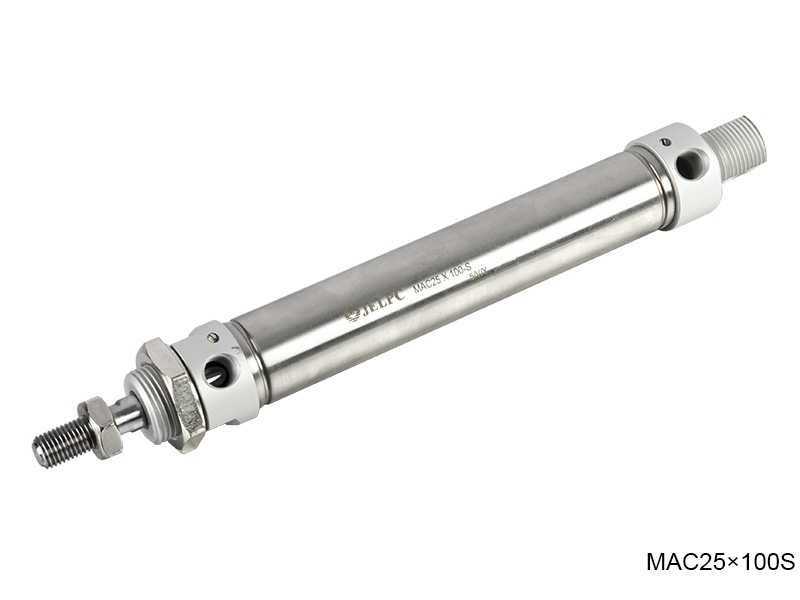The single-piston rod hydraulic cylinder is mainly composed of cylinder bottom, cylinder tube, cylinder head, piston, piston rod and guide sleeve. One end of the cylinder barrel is welded to the cylinder bottom, and the other end is threaded to the cylinder head. The piston and the piston rod are connected by a snap key. In order to ensure the reliable sealing of the hydraulic cylinder, a sealing ring and a dustproof ring are arranged at the corresponding parts.
Cylinder assembly
The cylinder barrel is the main body of the hydraulic cylinder, and its inner hole is generally manufactured by precision processing techniques such as boring, reaming, rolling or honing, and the surface roughness is required to be 0.1μm~0.4μm. The end cover is installed at both ends of the cylinder barrel to form a closed oil cavity with the cylinder barrel, which also bears great hydraulic pressure. Therefore, the end cover and its connecting parts should have sufficient strength. The guide sleeve guides and supports the piston rod or plunger. Some hydraulic cylinders do not have a guide sleeve and are directly guided by the end cover hole.
Piston assembly
The piston assembly is composed of pistons, seals, piston rods and connecting parts.
The piston device is mainly used to prevent the leakage of hydraulic oil. The basic requirement of the sealing device is to have good sealing performance, and automatically improve the sealing performance with the increase of pressure. In addition, the frictional resistance should be small and oil-resistant.
The oil cylinder is mainly sealed by a sealing ring. The sealing ring has O-shaped, V-shaped, Y-shaped and combined types, and its materials are oil-resistant rubber, nylon, polyurethane, etc.
(1) O-ring seal
The cross-section of the O-ring seal is circular and is mainly used for static sealing. Compared with the lip seal ring, the movement resistance is larger, and it is easy to twist when it is used for the movement seal. Therefore, it is generally not used for the oil cylinder movement seal alone.
The principle of O-ring sealing: When installing any shape of sealing ring, proper pre-compression must be guaranteed. If it is too small, it cannot be sealed, and if it is too large, the friction will increase and it is easy to be damaged. Therefore, the groove size and surface accuracy of the sealing ring must be strictly guaranteed according to the data given in the relevant manual.
In the dynamic seal, when the pressure is greater than 10MPa, the O-ring will be squeezed into the gap and damaged. For this reason, a retaining ring made of PTFE or nylon should be installed on the low-pressure side of the O-ring. When high pressure is applied in both directions , The retaining ring must be added on both sides.
(2) V-shaped sealing ring
The cross section of the V-shaped ring is V-shaped, and the V-shaped sealing device is composed of a pressure ring, a V-shaped ring and a supporting ring. When the working pressure is higher than 10MPa, the number of V-rings can be increased to improve the sealing effect. When installing, the opening of the V-ring should face the side with high pressure.
(3) Y (Yx)-shaped sealing ring
The cross-section of the Y-shaped sealing ring is Y-shaped, which is a lip-shaped sealing ring. It is a kind of sealing ring with low friction resistance and long service life, which is widely used. Y-shaped ring is mainly used for reciprocating sealing. According to the ratio of the length and width of the section, the Y-shaped ring can be divided into two forms: wide section and narrow section.
Buffer device
When the hydraulic cylinder drives the parts with larger mass to make rapid reciprocating motion, the moving parts have great kinetic energy, so when the piston moves to the end of the hydraulic cylinder, it will collide with the end cover, causing impact and noise. This mechanical shock not only causes damage to the relevant parts of the hydraulic cylinder, but also causes damage to other related machinery. In order to prevent this hazard and ensure safety, buffer measures should be taken to control the movement speed of the hydraulic cylinder.
Exhaust
The hydraulic transmission system is often mixed with air, making the system unstable, causing vibration, crawling, or forward rushing. In severe cases, the system cannot work normally. Therefore, when designing hydraulic cylinders, air removal must be considered.
For hydraulic cylinders and large hydraulic cylinders that require high speed stability, special exhaust devices, such as exhaust plugs, exhaust valves, etc., are often installed at the highest point of the hydraulic cylinder. After loosening the vent plug or the locking screw of the valve, the low-pressure reciprocating movement several times, the oil with bubbles will be discharged, after the air is exhausted, tighten the screw, and the hydraulic cylinder will be normal.
